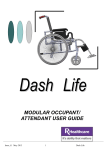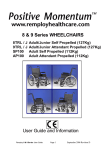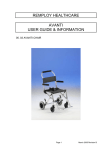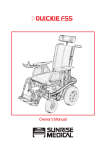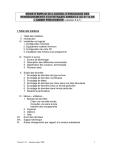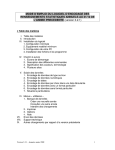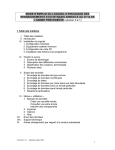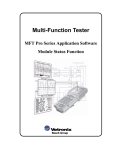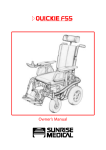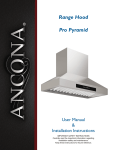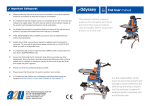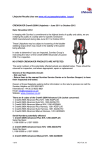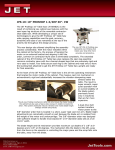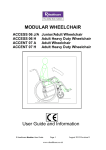Download MODULAR OCCUPANT/ ATTENDANT USER GUIDE
Transcript
Dash Lite MODULAR OCCUPANT/ ATTENDANT USER GUIDE ______________________________________________________________________________________________ Issue_G_January_2013 1 Dash Lite Table of Contents: Item Page: 1 Amendment Record 2 2 Important Symbols 3 3 Wheelchair Features 4 4 General Warnings 5 5 Intended User 5 6 Important Product Information 6 7 Handling and Stability on Steps and Slopes 10 8 Seat and Posture Belts 10 9 Occupant Controlled Mobility 12 10 Transportation 12 11 Tie Down Information 13 12 Safety Precautions 15 13 Wheelchair Cleaning and Maintenance 16 14 Service Checklist 17 15 Useful Addresses 17 16 Wheelchair Technical Information 18 17 Distributor Stamp / Information 19 IMPORTANT: DO NOT USE YOUR WHEELCHAIR UNTIL THIS MANUAL HAS BEEN READ AND UNDERSTOOD. www.Rhealthcare.co.uk Amendment Record: ISSUE B C D E PAGE Front Cover / 3 Page 7 Pages 18 / 9 Page 8 F G Page 11 Front Cover AMENDMENT Remploy Logo & ISO 9001 2008 compliance Brake warning note added 17” Model added to range, Tray Bracket info added Additional picture added to show backrest hinge release, chair photos changed Loop lapstrap design replaced by side fastening lapstrap R Healthcare Brand Change DATE Jun-09 Aug-10 Nov-10 Mar-11 July 2011 Jan 2013 ______________________________________________________________________________________________ Issue_G_January_2013 2 Dash Lite 1.1 IMPORTANT SYMBOLS IN THIS MANUAL THIS SYMBOL WARNS YOU OF A RISK! This symbol is used to give a warning or caution that is related to the safe use of the wheelchair. Follow the instructions to avoid personal injury or damage to the product. This symbol indicates hints and suggestions, which should help make operating the wheelchair easier and point out any special functions. This symbol indicates hints and suggestions that should not be carried out while operating the wheelchair. This symbol indicates the use of different tools and other adjustments or when service/maintenance may be required. It should only be carried out by suitably trained or competent persons. 1.2 WHEELCHAIR IDENTIFICATION Each wheelchair carries a unique identification/serial number that is printed on the serial number label. This label is fitted on the rear of the wheelchair on the rear cross brace tube (Fig. 1) This label also carries the model code designation, which includes the wheelchair size and colour. In the event of any queries please have this information to hand if contacting R Healthcare. Fig. 1 Label/Decal Placement Company specific labelling / decals as shown 1. Dash Lite stickers are situated on the front of the bottom tube, 2 per chair, one on each side frame Remploy Healthcare can be contacted as follows: 2. R Healthcare stickers are situated on the front of the side frame top tube, 2 per chair, one on each side frame Remploy Healthcare, Sheffield Road, Whittington Moor, Chesterfield, Derbyshire, S41 8NJ Customer services: 0044+ 0870 60 90 600, e-mail: [email protected] Website: http://www.remployhealthcare.com CARELESSNESS CAUSES FIRE 1.3. CARLESSNESS CAUSES FIRE This label shows the position of tie down location points for wheelchair transport. (See section 6.3 on transportation) This label shows the model number, serial number, max. User weight and manufacturer details. This label shows the flame retardency details. The label is fitted to the rear of the backrest and seat. 1.4. RULES AND REGULATIONS • The wheelchair is manufactured to meet the requirements of BS EN 12183 • The Upholstery meets the requirements of ISO 7176-16 and the fire and furnishing regulations SI1324. Other materials wherever possible are ignition retardant. 1.5. MODIFICATIONS AND ALTERATIONS Making any unauthorised modifications or using non approved parts, may change the wheelchair structure and create an unsafe condition. Remploy Healthcare Ltd BS EN ISO 9001 2008 Registered Firm BATCH DATE REFERENCE QUALITY ASSURED MATERIALS & CONSTRUCTION to SI 1324 furniture and fire regulations 1988 Outer covering is polymer coated fabric there is no interliner cushion combustion modified polyurethane foam padded quilting is PVC foam ALL MATERIALS TO APPROVED STANDARDS ______________________________________________________________________________________________ Issue_G_January_2013 3 Dash Lite Neither RHealthcare nor your wheelchair provider will accept responsibility for damage caused by misuse or noncompliance with instructions or advice set out in this manual. Users attempting to use the wheelchair beyond the manufacturer’s recommendations may put themselves at risk of serious injury or even death. 1. WHEELCHAIR FEATURES 1.1 DESCRIPTION OF WHEELCHAIR The Dash Lite self-propelling folding wheelchair is fitted with 61cm (24”) diameter wheels and the Dash Lite attendant propelled (transit) wheelchair is fitted with 31cm (12”) diameter wheels. The standard configuration for the wheelchair is shown below which identifies the key components. 1. Push handle 2. Backrest 3. Armrest 4. Footrest 5. Footplate 6. Front castor 7. Brake 2. Backrest 3. Armrest 1. Push Handle 4. Footrest 7. Brake 5. Footplate 6. Front Castor ______________________________________________________________________________________________ Issue_G_January_2013 4 Dash Lite 2. GENERAL WARNINGS The removal of detachable parts that are supplied either as standard as prescribed or recommended by the user’s prescriber, healthcare professional or wheelchair dealer, other than for the purpose of storing or transporting the wheelchair is not recommended and may compromise the correct use of the wheelchair by the user and the provision of any beneficial effects from the complete equipment. Take precautions when using your wheelchair to avoid fire risks, such as avoiding smoking or parking against open fires or heat source. Do not store your chair in direct sunlight. Direct heat such as sunlight will increase the temperature of parts on the wheelchair such as the frame or upholstery and they may be hot to touch. Low temperatures such as frost will have the opposite effect and may make parts of the frame very cold to touch. DO NOT hang items such as bags on the back of the push handles, as this can overload the chair and affect the stability of the wheelchair - causing it to tip over. DO NOT exceed the occupant weight limit for your chair and do not carry more than one person. If you feel that your body weight may have changed then contact your healthcare specialist. DO NOT attempt to lift the chair by any other means than the handle provided on the seat canvas. Using a cushion raises the seated position and may reduce the stability of your wheelchair. Some features and accessories may affect stability. Your healthcare professional can provide guidance on the stability of your wheelchair and should be consulted when cushions and accessories are being used. Your wheelchair should be delivered already assembled. You should remove any packaging before use. If you have not used a wheelchair or are uncertain about any of the features of your wheelchair then please contact your healthcare professional, wheelchair dealer or your wheelchair service and ask for assistance. If you have been informed that you must receive specific instructions about your wheelchair before using it, then it is important that you await this instruction for your own safety. 1. Turn the heel loops, if fitted, to the front of the footplate and then flip up the footplates. 2. Grasp the middle of the seat fabric at both front and rear and give a sharp pull upwards. This will part all close the chair. 3. Push both sides together to fold the chair completely. Ensure that the seat is not trapped in the frame when fully folded. 4. If required, fold the backrest down by pulling up the levers and lowering the push handles. 3. Intended use Your wheelchair is intended for use in the home, the office, public places and buildings, on pavements, pedestrian paths and firm surfaces. It is intended to assist with the mobility of the user on the seat and should not be used as a ladder or as a means of pulling or transporting items, or similar. Do not use the wheelchair on soft surfaces such as sand, deep snow, slush or mud as this may affect the stability. Care should be exercised when using the wheelchair on wet or slippery surfaces such as wet cobbles or icy pavements, as these may cause the wheels to slip or may cause carers/attendants controlling the wheelchair to slip. Using your wheelchair during darkness or in poorly lit areas. When using your wheelchair during darkness or in poorly lit areas, then consideration should be given to the use of high visibility markers or reflectors that can be fitted to the wheelchair or the use of high visibility/reflective clothing such as fluorescent waistcoats, belts or armbands, particularly in poorly lit areas or when crossing the road. Maximum safe slope The maximum safe slope for this wheelchair is 8 degrees. (This represents a slope of approx 1 in 6). See further notes and guidance in section 4.7 on wheelchair stability. Users, carers and attendants attempting to use the wheelchair beyond the manufacturer’s recommendations may put themselves at risk of serious injury or even death. ______________________________________________________________________________________________ Issue_G_January_2013 5 Dash Lite 4. IMPORTANT INFORMATION Getting out of the wheelchair. Make sure that the brakes are on, then flip up the footrests or detach them. The occupant should place a hand on each armrest, bend slightly forward and place both feet well back. INTRODUCTION The type of wheelchair, and attachment features, provided will be different according to individual user requirements, and clinical assessment of need. In many cases the result will be a compromise solution. 4.3 SIDE TRANSFER When the wheelchair armrest is removed, it will allow sideways entry to the chair and vice versa, from another chair or car seat. See fig 3. Physically active Independent users with upper body and arm strength Some modular wheelchairs can be set up or finely adjusted to suit user needs. Users should contact their approved distributor if they are having problem in using their wheelchair, a simple adjustment or alternative build configuration may help to resolve the problem. Should eventually develop skill to carry out this manoeuvre without help. However, it is advisable that an attendant should be available if assistance becomes necessary. Remploy manual wheelchairs can be divided into two broad categories. • • Attendant Propelled Occupant Propelled Make sure the brakes are on, or that the wheelchair is prevented from moving, It is easier to transfer when flip up This general information section covers safety issues of wheelchair use covering all of these. Please read carefully together with all other information provided, covering the specific model supplied, which will give particular details of the wheelchair features and construction, methods of operation and correct setting methods. 4.2 footrest assemblies are swung back out of the way, or removed so as not to interfere with the legs. Feet should be firmly on the ground and not on the footrest. The safest way to transfer is to bend slightly forward. GETTING IN AND OUT OF A WHEELCHAIR FACING FORWARDS If there is a gap between the two seat surfaces, it may help to slide along a smooth transfer board, or to use some other lever point such as a car hand grip for additional support whilst manoeuvring from one seat to the other. For maximum safety, these operations should be carried out with the help of an attendant. The occupant should always try to assist the attendant wherever possible to share the total effort. Carers should not attempt to lift without help. If this is not possible a hoist may be required. Getting into the wheelchair. Make sure that the brakes are on, flip up the footplates, taking care that the heel support straps (if fitted) are not jammed against the footrest support frame. On some models, footrests may be detached or swung away for easier access. Note that when footrests are detached, the mounting swivels remain exposed and care should be taken to avoid the occupant catching these accidentally. DO NOT ATTEMPT SIDE TRANSFER ON SLIPPERY OR UNEVEN FLOORS Fig 2 - Getting in/out of the wheelchair The occupant may be able to help by pushing on the armrests to provide support whilst being lowered into the seat. Finally, push the footplates down, and locate the occupant’s feet on them. see fig 2. ______________________________________________________________________________________________ Issue_G_January_2013 6 Dash Lite Fig 3 – Side Transfer 4.5 PUSHING TECHNIQUES Pushing a wheelchair with a helpful occupant can be an enjoyment for both people involved provided that there is mutual confidence and understanding. When first planning a trip, the pusher should check the distance and terrain to be covered, bearing in mind that a slope going out is a hill coming back. A combination of slope and camber is common in many areas. Try the chair out on typical surface conditions nearby, and practice manoeuvres likely to be encountered on a longer trip. Fig 4 – Maintain a firm grip on the push handles The pusher should be familiar with the operation of the wheelchair, remembering to put the brakes on and steady the chair before the occupant gets in and out. Where applicable, detachable features such as push handles and armrests should be checked for security, before setting out on a journey. The occupant should not be rushed during transferring in and out of the chair. Fig 5 – Attendant Control 4.4 Before setting off, the pusher should make sure that the occupant is comfortable and that clothes, rugs, covers etc do not catch in the wheels or interfere with the general workings of the wheelchair. BRAKES The pusher should walk at a sensible speed, and tell the occupant before changing position, tipping the chair or manoeuvring, also paying attention to the surface conditions and avoiding uneven or soft ground wherever possible. Hand brakes are provided for preventing wheel movement when parked, particularly on a slope, or during occupant transfer to and from the wheelchair. The action of a brake shoe pressing on the tyre makes correct inflation pressure important. The pusher should always maintain a firm grip on the push handles. The chair should not be jolted or jarred, or rocked like a pram. see figs 4 & 5. Cable operated hub brakes are an option available for mounting on the push handles to allow the attendant to control the chair without having to reach down for the hand brake handle. These may also provide the attendant with a means of controlling the speed of a wheelchair when going downhill, and are a safety improvement on slopes and undulating terrain, as described in Technical Information Manual (Part B). Shopping bags or other additional heavy loads should not be carried in a wheelchair unless specifically designed for the purpose. This particularly applies to hanging items over the push handles, which can overload the chair and affect stability resulting in injury if the occupant tips out of the chair when it is left unattended momentarily. Operating the wheelchair in this way however, demands that the attendant is skilled in the controlling operation, as a sudden change in direction will result if one wheel is retarded in advance of the other. Fig 6 – Going down a kerb Start position Brake adjustment— Loosen sideframe brake bracket clamp, and drop brake sub assembly until there is a 5mm gap between the brake while in the off position and tyre. Tighten and secure to 1oft/lbs ensuring tyre is central to the brake shoe. Images showing extending brake handle When setting the brake; please ensure that when the brake is on, the rotation of the swinger assemblies; does not disengage the brake. ______________________________________________________________________________________________ Issue_G_January_2013 7 Dash Lite Make sure that the front end of the chair is lowered slowly to the floor, and that the castors are pointing to the rear. Going up a kerb. First method. The chair footplates, or occupant feet if longer, should be taken to just in front of the kerb edge. The pusher should hold the chair handles firmly, pressing down on the tipping lever, tilting the chair backwards using body weight leverage, bringing chair forward till the back wheels touch the kerb. Fig 7 – Going down a kerb Finish position The front castors wheels can then be lowered down onto the path, making sure that the wheels are facing rearwards. With the push handles held firmly the attendant should now lift and push the chair. Castors with small wheels, are more liable to dig in, than large wheels, and require extra care in use. Going up a kerb. Second method. 4.6 The chair should be turned round so that the back wheels are against the kerb and the attendant should hold the pushing handles firmly and tip the chair backwards. KERBS Negotiating a kerb. The methods described here involve an attendant controlling the operation. Active users adopt balancing techniques carry out kerb manoeuvres independently, but methods will vary according to the setting of the chair, the physical strength of the user and skills acquired through training and practice with wheelchair experts. See section 1.6. Using body weight as leverage the attendant should then pull the chair off the kerb and up onto the pavement, making sure, as above that the castor wheels are facing rearwards. The chair may then be pivoted to face the direction of travel and pushed forward. Going down a kerb: The chair castors should be taken to the edge of the kerb. The pusher should hold the chair handles firmly, pressing down on the tipping lever and at the same time tilting the chair back. see fig 6 & 7. The rear wheels can then be taken to the kerb edge and the foot removed from the tipping lever. The chair is then lowered down the kerb on its rear wheels, with the castor wheels facing rearwards, this prevents them jamming up momentarily as the chair starts to move, before pivoting the chair gently to the ground, to face direction of travel and then pushing forward. Fig 8 – Apply pressure to release and engage push handle as per above. Ensure that push handle locks are fully engaged before using the chair. Fig 9 – Going down/up a flight of steps Note: The chair must not be tipped for ward or the occupant may fall out. When stabilisers have been fitted, this operation is more difficult to control, and extra care should be taken. ______________________________________________________________________________________________ Issue_G_January_2013 8 Dash Lite Wheel Mounting Bracket. Never mount the quick release rear axles with the release button positioned inside the frame. This will cause the wheels to release when the chair is folded. The image below shows show how the block is fitted to the chair and how the wheel alignment can be set using the grub screws in the wheel mount block. Do not alter the position of the wheels in the wheel mounting blocks without the approval of the person prescribing the wheelchair. Remploy recommends that trained personnel configure the chair and carry out necessary adjustments following professional assessment. Tray Bracket Is fitted on either armrest utilized the front two armrest / side panel screws Footrest Wheel Assembly. Correct positioning of the footrests to suit occupant size and position is very important as it has a major effect on distribution of seating pressure. The underside of the occupant’s legs should be supported as far forward as possible over the length of the seat, to reduce high-pressure areas. When transferring to and from the wheelchair, avoid contact and weight on the footrest, as this will cause the wheelchair to tip forwards. To detach the footrest assembly: Pull the lever ’a’ upwards and swing the footrest outwards and lift out of the frame. To attach the footrest assembly: Locate the footrest in the front frame and swing it round to the centre of the wheelchair until it locks securely into position. ‘a’ Keep fingers and other items away from the footrest attachment assembly when it is being attached to prevent injury or damage to property. 4.2 FOOTPLATE ADJUSTMENT The footplates are height adjustable. Tools required: 5mm Allen Key Quick release self - propelling wheels Your wheelchair may be fitted with quick release wheels. Quick release wheels can be removed from the wheelchair to make it lighter for lifting and easier to store. To remove wheel: Press the button (1) in the centre of the wheel and slide the axle and wheel out of the axle bush fully. To replace wheels: Reverse the above procedure and depress the centre button of the axle and push the exposed axle into the wheel bush. When the axle/wheels are fully inserted, release the centre button. Height adjustment With the user sitting in the wheelchair, lower the footplate and ensure that it is in a comfortable position for their feet. The safest position is usually with thighs horizontal, and hips and knees at right angles. If the position is not comfortable the footplate can be adjusted as follows: Stabilizer Stabilizers can be fitted if there is a risk of the user tipping the chair backwards. Their position affects the angle that the chair can tip back to before it touches the ground. Remploy recommends that trained personnel configure the chair and carry out necessary adjustments following professional assessment prior to use Make sure that the button is fully released and that the wheel is secure in the axle bush by pulling the wheel gently away from the wheelchair. The wheel should remain in the same place. Always ensure that the quick release wheels are fully engaged with the locking ball bearings on the axle shaft fully engaged and visible on the inner side of the axle bush. Adjusting the stabiliser can adversely effects the performance of the stabiliser ______________________________________________________________________________________________ Issue_G_January_2013 9 Dash Lite 4.7 HANDLING & STABILITY ON STEPS & SLOPES Where possible, the hazard of negotiating steps should be avoided. Many falls and injuries to both occupant and helper can occur when inexperienced people are carrying out this operation, and if users or carers are concerned about a particular hazard in the usage environment, which they must regularly overcome, they should consult their wheelchair rehabilitation service, or community services department, as appropriate. DO NOT ATTEMPT SIDE TRANSFER ON SLIPPERY OR UNEVEN FLOORS A little forward planning can eliminate difficult manoeuvres such as steps. Modern public buildings should provide permanent wheelchair ramps, with a practical slope angle, built according to regulations, for safe access. There may still be occasions when steps must be negotiated. In the event of the chair having detachable pushing handles, these should be checked for security in the locked position before attempting this manoeuvre. Stabilisers may require removal if they interfere with the chair balance angle on a flight of steps. This should first be checked out with an unoccupied chair. Technical Test data on stability of wheelchairs should be seen as a tool for comparison. Data does not convey actual feel of the wheelchair in the intended environment. Initial supervised user training and assessment by a rehabilitation professional, with the wheelchair in the intended usage environment is recommended, and users should ensure that they are confident with regard to this aspect of use. An important factor in considering accessibility and slopes is the effort demanded from the occupant or attendant using the chair (attendant brakes are an available option). Pushing up a steep slope which extends over a distance, may create a need to stop and rest, which in turn demands additional and undesirable effort to start back upwards again. Stopping a wheelchair on a steep downward slope also demands effort and control, and surface conditions need to be taken into account when deciding what outdoor route to take. Manoeuvres, which demand over exertion, may create risk of injury to the user and should be avoided. However, if in temporary difficulty, wheelchair users should not hesitate in asking for assistance from people nearby, someone will usually be happy to help. Two attendants at least are required for this operation. The attendant supporting the main load should grip the chair at the push handles, and repeat the procedure as section 2.6 for getting down a kerb at each step, the second attendant at the front will be required to guiding the footrest area, and provide reassurance to the occupant. A third person could act as guide for the chair team if the steps are high. Reverse this procedure for going up a flight of steps, with the attendant supporting the main load at the push handles pulling, and the second attendant at the front guiding the chair using the corner of each side frame. Specialist training for very experienced users to negotiate a flight of stairs independently is available, but this is beyond the context of this guide. .8 SEATBELTS (ALSO POSTURE BELTS) The fitting of these should be considered in all circumstances where the chair is used outdoors, over a sloping surface or kerbs. Belts normally secure the occupant by means of a quick release buckle in the centre. In cases where the seatbelt is part of the postural/ clinically assessed needs, provision of a seatbelt will be covered by a clinical assessment. Modern buildings should have slopes built to a required standard angle, but this is not the case with all access areas. Learning the geography of an area is important. As an all round guide, a maximum safe slope of 8 degrees is our recommendation for the Remploy range of manually propelled wheelchairs. However this recommendation may need to be changed if the wheelchair has attachments added to it, such as an elevating legrest or carry bag, which adversely affects stability. Such changes to the chair specification may have a critical effect, and they require re-assessment by rehabilitation professional. A basic security seat belt may become required after a period of use, if the environment or method of use changes, or where the occupant feels a need for greater security in the wheelchair. These can be fitted retrospectively by a fully trained and competent technician, but if unable to utilise any of these instructions, contact either your NHS rehabilitation engineer or the manufacturer of the wheelchair. SAFE SLOPE OF 8 DEGREES FOR MANUAL WHEELCHAIRS ______________________________________________________________________________________________ Issue_G_January_2013 10 Dash Lite Fig 10 A correctly fitted posture belt should fit over a users pelvis at approximately 45 degrees from the anchor without obstruction from any part of the wheelchair (e.g. skirt guard or armrest). The posture belt should be adjusted so as to fit snugly around the user’s pelvis to provide an appropriate sitting position. The adjustment of the belt must be carried out by a competent person who is able to assess the client’s needs and frequency of checking of the belt adjustment. The Posture Belt (Fig 10a) affixes direct to the side frame as per photo using existing fastenings. Future reviews of an individuals needs should include consideration of the appropriateness of the posture belt and its method of adjustment, fastening and release especially where a users’ or carers’ capabilities change over time. Lengthening or shortening, is affected by slackening and adjusting the webbing, as it passes through the male part of the fastener until the desired fit is obtained. When adjusted ensure the webbing is tightened, the buckle is located centrally, and the surplus webbing is secured by the tri-glide provided. Inspection and maintenance of posture belts and their fittings should be included within the planned preventative maintenance programme for the wheelchair. Fig 11 Wheelchair seatbelts are not tested to meet the crash test standards required for occupant restraint in a vehicle, but we advise that they should remain in position during a journey to provide occupant security, and support during normal traffic movements of sideways cornering and speed changes. Transportation, crash tested restraints for both wheelchair and occupant are part of the actual vehicle equipment, and must be secured to the vehicle itself, as shown in Fig.11 See section 2.10 of this General Guide for more details. WARNING – DO NOT disassemble, shorten, cut or drill this retaining belt, it could seriously compromise the belts integrity and invalidate any manufacturers warranty. . Clean if required, using a damp cloth with a small amount of washing up liquid. Rinse with a clean damp cloth. All of our belts have flame retardant properties. Preferred Zone ______________________________________________________________________________________________ Issue_G_January_2013 11 Dash Lite 4.9 OCCUPANT CONTROLLED MOBILITY STABILISERS ARE FOR OCCUPANT SAFETY. THEY SHOULD NOT BE REMOVED UNTIL THE USER IS ABLE TO DEAL WITH BACKWARD FALLS AND TIP OUTS Handrims These are provided for the occupant to grip and push round to propel the wheels. Best results will be obtained by a long pushing stroke, which gives a continuous and smooth forward motion. Many users find that gripping across the tyre and handrim at the same time gives better control. We recommend that when operating in this way, wheelchair gloves are worn. If stabilisers are removed for ascending or descending a flight of steps additional carers and handlers should be present, and they should be refitted when the manoeuvre has been completed. Users with gripping difficulties may find larger section or Capstan types, with easy grip features, more practical. Outdoor Safety Hints Most pavements slope slightly towards the kerb and the wheelchair may have a tendency to pull towards the road. Occupant controlled Active User wheelchairs with cambered wheel setting reduce this tendency. When using a handrim to turn a chair round in a tight space, push one wheel forward, whilst pulling the other wheel backwards. Always make sure when carrying out this manoeuvre, that there are no obstructions or bystanders in the turning space required. The fitting of polyurethane tyres eliminates punctures, and provides reassurance of not being stranded some distance from a service centre, but the use of these tyres imposes a harder ride and the wheels must be checked more frequently, to ensure that there is no deterioration of spoke tension and security. Polyurethane tyres have slightly less grip than pneumatic tyres, therefore, self propelled chairs fitted with polyurethane tyres are also fitted with a high friction brake shoe grip. Balance Training Physically active, independent people require wheelchairs, which allow them to safely negotiate kerbs and achieve efficient control and manoeuvrability. It can be hazardous for an occupant to attempt wheelie positions on wheelchairs, which are stable above 10 degrees rearwards static stability, as physical effort needed to manoeuvre and pull a wheelie can be excessive, consequently increasing the risk of accidentally tipping over backwards. When out at night, ensure that both you and your wheelchair are visible, consider both clothing, and light reflective trim features. 4.10 Maximum efficiency of hand propulsion occurs when occupant centre of gravity and wheel centre coincide, and is dependent on the occupant shape and size. Physically active people should have wheelchairs with fine wheel position balance settings, i.e. below 10 degrees rearward stability. These chairs should have rear stabilisers when supplied to inexperienced users, allowing the user to practice balancing techniques with the reassurance that the chair will not accidentally tip over backwards. TRANSPORTATION Wherever possible it is recommended that wheelchair occupants transfer to a vehicle seat during a journey, with the wheelchair securely stored separately in a purpose made storage area. Stowing the wheelchair in a car boot The folded chair should be placed close to the car boot with armrests, footrests and other removable parts detached to split total weight into component form. Wheelchairs with detachable wheels reduce the weight for lifting. The person stowing the chair should grip convenient fixed parts of the chair, and lift keeping the back straight, bending from the hips and knees. If in any doubt about handling the weight, assistance should be sought. During training, the Therapist, or Training Supervisor can therefore build up the confidence of the occupant in stages, by initially setting the wheelchair up in a safe balance position, with the stabilisers acting positively, and progressing gradually towards optimum performance settings, with the stabilisers only acting as a back up. Once satisfied that the occupant has developed the full range of wheelchair skills, and provided that the medical condition is not compromised, the therapist can authorise removal of the stabilisers, and the occupant then takes full responsibility and control of the wheelchair. ______________________________________________________________________________________________ Issue_G_January_2013 12 Dash Lite Car Driver Information Guidelines for Wheelchair & Occupant Transportation in Vehicles This information is given in order to reduce the risk of bad practice. It is based on current available knowledge. Wheelchair users and transport operators have a responsibility to ensure that safety measures take account the needs of wheelchair occupants and other passengers to minimise the risks involved for each individual situation. Vehicles transporting wheelchair occupants should have safe, secure wheelchair access, transport operators should recognise this. Available publications are Safe Transportation of Wheelchairs, DB2001(03) June 2001, Safe Use of Wheelchairs and Vehicle mounted Passenger Lifts. DB2003(03). Physically active wheelchair users can drive cars and store the wheelchair in the car independently, with a lot of practice. Training at specialist driving centres is recommended. Two door cars provide the greatest access space. Gaining entry to the car first involves side transfer as section 3. When carrying this manoeuvre wheelchair users should chose a position where there is no risk of interference from other traffic. The stored wheelchair requires locating not only so that the driver can reach it, but also to remain safely secured during the journey. With sideways folding wheelchairs the driver should pull the folded wheelchair into the vehicle into space behind driver or passenger seat. see figs 12 &13. Public Transport Wheelchair users who choose to travel in a local bus or public service vehicle should recognise that this involves risk, and a complexity of related issues. The user has a responsibility to make the decision of how to travel carefully. Pre journey planning will avoid difficult access situations, which could be encountered later, when it is too late to do anything about it. In busy, congested areas, users will require skill to avoid collisions with other passengers, when approaching and boarding the vehicle. Wheelchair brakes may not hold a chair and occupant stable against inertia forces of normal traffic conditions, such as cornering or coming to a halt, and wheelchairs in vehicles should be prevented from moving by other means. Dept of Transport approved designated wheelchair areas in low floor buses with support pillars and hand rails at wheelchair height are the most suitable. Users are advised to check availability of wheelchair facilities with the transport vehicle operator, and note time schedules. Fixed frame wheelchairs, with quickly detachable wheels can be disassembled once the driver has transferred into the car. The parts then being stored safely within the vehicle. It is recommended that wheelchairs stored on the front passenger seat are secured using the car seat belt through the frame. A wheel bag may be useful for long journeys or for keeping dirt away from the car seating area. When there is another able bodied passenger present, the storing options as section 9.1 are recommended. FIG 13 A Sideways Folding wheelchair can be stored behind the front seat. Specialised Transport for Wheelchair Occupants. These vehicles should be fitted with approved restraint systems. Dept of Transport approved taxis for individuals are available, but users with neck problems are advised to check that there is adequate headroom. Restraint systems for minibuses range from wheelchair tie downs, to more compact foldaway devices. Installers and operators of vehicles with restraint systems must be trained in their correct use by the restraint manufacturer, or approved mobility specialist. The CTA can provide useful advice. Remploy have actively participated in the creation of new safety standards in this area through membership of BSTA, in co-operation with the Dept of Transport & B.S I. The resultant standard, BS EN ISO 10542 states the following: FIG 14 ______________________________________________________________________________________________ Issue_G_January_2013 13 Dash Lite The wheelchair must be secured to the floor by a restraint system, preferably in line with direction of travel. The wheelchair should not be occupied by more than one person. Fittings such as trays should be stowed separately. Wheelchairs used for transportation of occupants in vehicles should have a full height backrest of at least 415 mm for adults, head supports are recommended. 4.11 TIE DOWN PROCEDURE Remploy recommend Unwin Tie Down and Occupant Restraints. Unwin’s provide in depth training courses for the application of their products which meet the ISO 10542 standards, and have a proven test record with the Remploy wheelchair range. We recommend that persons responsible for securing wheelchairs in vehicles attend an Unwin training course, or any other informative training applicable to the usage environment. Restraint systems should only be fitted in specially adapted vehicles, where the structure has been strengthened to take wheelchair location points. Details of Unwin systems we have tested are as follows. There are similar products available from other suppliers, which we know, have also been tested satisfactorily, and if used these should be applied as per the suppliers recommendation. Tie Down Point labels on all Remploy supplied chairs indicate the correct position to attach karabiner type chair restraints. Continuous product improvement has resulted in new design chairs having specific tie down karabiner locations to enable correct and easy attachment by the transport operator. The following reference covers Unwin chair restraints only. WHEELCHAIR RESTRAINT TYPE UNWIN PART NO. DASH LITE 4 Point Webbing with Karabiner W120 The model Dash has been crashed tested successfully to ISO 7176-19 which is for forward facing with tie downs. Wheelchair Seat Belts and Posture Belts are not crash tested restraints, although they help keep an occupant in a preferred position during normal vehicle motion. To meet crash safety standards, wheelchair and occupant must be secured to the vehicle independently. The occupant restraint should be secured directly to the vehicle at a point above shoulder height. No component of a wheelchair restraint should pass through the wheels. Wheelchair restraints should secure the wheelchair in such a manner that they cannot become free if chair components deform, or if one or more tyres deflate. Under no circumstances should wheelchairs be modified or strained to allow installation of clamps or fittings. The side-view projected angle for the rear tiedown straps is between 30 o and 40o from the horizontal. The side-view projected angle for the front tiedown straps is between 40o and 60o The rear-view projected angle of the rear tiedown straps is within 10o of the wheelchair reference plane. The front-view projected angle of the front tiedown straps is within 25 o of the wheelchair reference plane, but angled so as to provide some lateral stability to the wheelchair. ______________________________________________________________________________________________ Issue_G_January_2013 14 Dash Lite FIRE PRECAUTIONS When using the chair, both indoors and outside, always take precautions against fire risks. Avoid smoking, and do not park the wheelchair against an open fire, or intense heat source. Bear in mind that the temperatures reached in a hatchback car on a hot day can cause stored wheelchair component parts to become too hot to handle. When parking, the pusher should position the chair so that the occupant can see and communicate as well as possible. In buildings check that fire exits and procedures are understood. DISABLED PERSONS ARE AT GREATER RISK THAN OTHERS IN THE EVENT OF A FIRE. THE ENVIRONMENT IN WHICH A WHEELCHAIR IS USED SHOULD INCORPORATE SAFETY PRECAUTIONS TO MINIMISE FIRE RISK TO WHEELCHAIR OCCUPANTS GENERAL PRECAUTIONS & INFORMATION Warranty Remploy Healthcare guarantees the products supplied to be free from manufacturing defects, and will replace components where necessary free of charge, for a period of 24 months from the date of purchase as long as the product has not been deemed to have been subject to miss-use. This guarantee is subject to the condition that the product has been used, adjusted and maintained in accordance with the user and maintenance instructions supplied by Remploy Healthcare. This does not affect your statutory rights. A more complete warranty statement is available on request from Authorised Distributor or Disablement Service Centre. The recommended lifetime of the model Dash Lite is Five years from purchase date. Service Service Records should be completed by the Authorised Distributor Servicing Department and retained by the user as a reference. Service checks should be carried out by the Authorised Distributor at the recommended interval specified on the Service Record. Batch code and serial numbers are essential for the specification of spare parts. If in doubt, your Authorised Dealer or Rehabilitation Specialist will be able to provide help and professional advice on correct and safe use of wheelchairs. There are also many national and local organisations, which will be pleased to provide help and advice for wheelchair users. All Remploy wheelchairs are designed with the needs of disabled people in mind. We hope that our wheelchairs provide their users with the reliability, freedom or independence they need for a more improved lifestyle. Remploy Healthcare Group has a policy of constant product improvement and reserves the right to change specifications without prior notice. This guide contains information of a general nature. All models and attachments have specific features and will have additional information provided showing correct operation method. UNAUTHORISED WHEELCHAIR MODIFICATIONS MAKE THIS WARRANTY VOID. REMPLOY ARE NOT RESPONSIBLE FOR ANY ACCIDENT RESULTING FROM SUCH UNAUTHORISED MODIFICATIONS. ______________________________________________________________________________________________ Issue_G_January_2013 15 Dash Lite LOOKING AFTER YOUR WHEELCHAIR - GENERAL CARE AND MAINTENANCE READ ALL INFORMATION PROVIDED BEFORE ATTEMPTING TO USE Users should not attempt major repairs or modifications. Approved Distributors have full Service Information and are able to advise if the chair becomes damaged, requiring major part replacement, or refitting. If in any doubt about service requirements, contact the Approved Distributor The Remploy Customer Services Dept is also available for more information The Service Record included with this Information Guide, has details of model references to be quoted when Service Information is requested. Frequency of distributor service maintenance depends on usage level. We recommend that chairs are checked by the distributor at assessed intervals, according to the level of use and usage environment. Warranty can be affected if a wheelchair is not adequately maintained. Users should note that wheelchairs retain appearance if looked after and cleaned regularly, referring to the list below for routine maintenance and safety checks, which they are responsible for. Information received from upholstery manufacturer The fabric used for wheelchair upholstery is easily cleaned in-situ. However, as there are some substances which may affect the material, careful attention to REGULAR cleaning will not only prolong its life but will ensure that its appearance is maintained. Resistance to stains and chemicals The upholstery is resistant to most mild acids, alkalis and household stains. Some substances such as ballpoint pen ink, lipstick, newsprint and food colourings may be absorbed by the vinyl and cause permanent staining. This can often be minimised by immediate cleaning with a damp, soapy cloth or sponge Cleaning To maintain its appearance, the fabric should be cleaned REGULARLY to remove fatty substances in soiling, which may reduce its service life. Light soiling can be removed by adding a small amount of washing up liquid to some warm water and then applying to the fabric with a cloth. Rinse off with clean water before allowing to dry. If need be, a Mild solution of antiseptic can be applied to the fabric. Do not use Chemical bleaching materials, abrasive cleaners, wax polishes or aerosol spray polishes. The use of these substances is likely to be harmful to PVC laminates and repeated use can result in the removal of plasticiser from the PVC compound which will result in hardening and subsequent cracking of the material’s surface. PRESERVATION & STORAGE If the wheelchair can not be kept indoors, then it is recommended as a minimum consideration that the wheelchair is stored in garage type conditions, away from wet or damp areas. During the course of general use, the wheelchair may become wet, due to rain and such events. When practical the wheelchair should be wiped down with a dry cloth, this is to reduce the risk of corrosion. Where wheelchairs are stored in the back of cars and similar transportation vehicles, there are occasions especially in hotter climatic conditions such as summer, it is advisable to cover the wheelchair with a suitable cover. This will reduce the risk of the wheel becoming hot, having an effect on user or carer handling the chair out of the vehicle. When a doubt exists, where the wheelchair has suffered constant miss use of storage, the wheelchair should be removed from the client, and disposed of. ______________________________________________________________________________________________ Issue_G_January_2013 16 Dash Lite SERVICE CHECK LIST Brakes The brake should hold the chair on a ramp angle of approx. 10 degrees. Try the chair on a slope or ramp, which you may use. If necessary, have the brake is readjusted. (See warning note on page 7) Wheels Check general condition, free running and clearance in hubs, wheel wobble of 3mm measured at rim is acceptable, excessive movement is an indication of wear. Chairs fitted with puncture free tyres in particular will require frequent checks on spoke security, and any spoke looseness or other fault should be brought to the attention of the Approved Distributor. Tyres Ensure correct tyre pressure, and tread condition. Valves are Schrader (as cars), pressure is 45 psi (3 Bar or 300 Kilo Pascal’s). To avoid risk of over inflation, we do not recommend use of high pressure airlines. Badly worn tyres should be replaced. Handrims Check security of fixing, and damage to surface which could cause cut fingers Moving Parts Occasional lubrication of sliding parts and pivots. We recommend the use of a non toxic lubricant is used e.g. Superlube Plus (from Lubrication Services) which is FDA approved for food use, will allow easy operation. Upholstery The upholstery should be wiped with a damp cloth. Marks can be removed using a mild detergent. Pressure washing is not recommended. Damage should be repaired before it causes problems. A slight catch in the upholstery may result in a longer tear if not dealt with when it first occurs. Frame and Fittings Paint work can be protected using a proprietary car wax polish. Check that all detachable parts latch in correctly and positively, particularly push handles, footrests, armrests and stabilisers where appropriate. Handgrips Ensure that the Handgrips are secure. If grips are loose or damaged the wheelchair is unsafe and the grips must be replaced. Replacement grips and method of fitting must be to Remploy approved specification. Useful addresses MHRA Medicines & Healthcare Unwin C.N.Unwin Ltd The Horseshoe Coat Road Martock Somerset TA12 6EY Tel 01935 827740 Fax 01935 827760 Website: www.unwin-safety.com Products Regulatory Agency Wheeled Mobility Centre 241 Bristol Avenue Bispham Blackpool FY2 0BR Tel 01253 596000 Fax 01253 596177 Website: www.mrha.gov.uk Remploy Healthcare Sheffield Road Whittington Chesterfield Derbyshire S41 8NJ Tel 0870 60 90 600 E-Mail: [email protected] Website: www.remployhealthcare.com BHTA British Healthcare Trades Association New Loom House Suite 4.06 101 Back Church Lane London E1 1LU 020 7702 2141 020 7680 4048 Website: www.bhta.com E-mail: [email protected] ______________________________________________________________________________________________ Issue_G_January_2013 17 Dash Lite 16" x 16" 17" x 17" 18" x 17" 127Kg 127Kg 127Kg Stump Support YES YES YES Elevating Legrest YES YES YES seat width 405mm(16") 430mm (17") 455mm (18") seat depth 405mm(16") 430mm (17") 430mm (17") effective width 415mm 440mm 465mm effective depth 415mm 440mm 440mm backrest canvas height 450mm 450mm 450mm 10 degrees 10 degrees 10 degrees Max occupant weight ( advised ) Seating area dimensions backrest frame angle from vertical seat frame angle from horizontal 5 degrees 5 degrees 5 degrees side transfer by swivelling arms upwards ALL MODELS ALL MODELS ALL MODELS compact outward swivelling footrest ALL MODELS ALL MODELS ALL MODELS 222 mm 222 mm 222 mm height of armrests occupant leg to seat angle 90 degrees 90 degrees 90 degrees footrest to seat adjustable height 310 / 420mm 310 / 420mm 310 / 420mm seat front edge to ground 480 mm (19") 480 mm (19") 480 mm (19") 934 mm 934 mm 934 mm 1430 mm 1430 mm 1430 mm 1540mm 1540mm 1540mm open width 600 mm 625 mm 650mm open length 958mm 958mm 958mm open height 934mm 934mm 934mm folded width 275mm 275mm 275mm folded length 692mm 692mm 692mm folded height 705mm 705mm 705mm 410 / 460mm 410 / 460mm 410 / 460mm push handle height Corridor widths to turn (315mm wheel) through 360 degrees between walls ( includes attendant ) Corridor widths to turn (24" wheel) through 360 degrees between walls ( includes attendant ) Overall dimensions (315mm) frame wheelbase Overall dimensions (24") open width 600mm 625mm 650mm open length 1080mm 1080mm 1080mm open height 934mm 934mm 934mm folded width 350mm 350mm 350mm folded length 1080mm 1080mm 1080mm folded height frame wheelbase 705mm 705mm 705mm 370mm / 420mm 370mm / 420mm 370mm / 420mm Rear wheel Quick Release ALL MODELS ALL MODELS ALL MODELS diameter 315mm / 610mm (24") 315mm / 610mm (24") 315mm / 610mm (24") width 40mm / 35mm / 35mm 40mm / 35mm / 35mm 40mm / 35mm / 35mm diameter 190 mm 190 mm 190 mm width 25 mm 25 mm 25 mm Total weight for lifting (Frame only 315mm) 8.0Kg 8.1Kg 8.2Kg 12.4 Kg 12.5 Kg 12.6 Kg 7.3Kg 7.3Kg 7.5Kg Front castor one type only Total weight for lifting (315mm, Including all det components) Total weight for lifting (Frame only 24") Total weight for lifting 24", (Including all det components) Dynamic test ISO 7176-8 ( Kerb Drop ) 13.6 Kg 13.8 Kg 14.0 Kg 6666 Drops 6666 Drops 6666 Drops Static Stability (315mm) forwards 7.0degrees (Wheels Slid) 7.0degrees (Wheels Slid) 7.0degrees (Wheels Slid) backwards 14.5 degrees 14.5 degrees 14.5 degrees sideways 11.0 degrees 11.0 degrees 11.0 degrees Static Stability (24") forwards 8.5 degrees (Wheels Slid) 8.5 degrees (Wheels Slid) 8.5 degrees (Wheels Slid) backwards 10.0 degrees 10.0 degrees 10.0 degrees sideways 13.0 degrees 13.0 degrees 13.0 degrees ______________________________________________________________________________________________ Issue_G_January_2013 18 Dash Lite R HEALTHCARE HEALTHCARE GROUP Distributed by: Other Approved Distributors: ______________________________________________________________________________________________ Issue_G_January_2013 19 Dash Lite



















